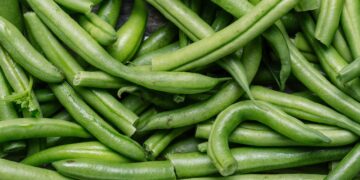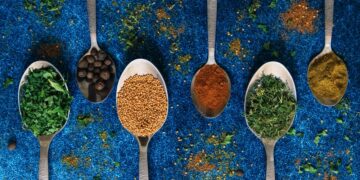Steak is a type of meat, typically beef, that is sliced perpendicular to the muscle fibers, potentially including a bone. It is usually cooked by grilling, pan-frying, broiling, or other methods to achieve the desired level of doneness. Whether you prefer it rare, medium-rare, or well-done, the type of steak you choose can significantly impact your dining experience. The quality and tenderness of a steak can depend on the cut of meat, the cooking method, and the degree of marbling (intramuscular fat). Each type of steak has its own unique characteristics. Some have thicker connective tissues, some have a high-fat content, and some are pure muscle.
Here are the different types of steak.
1. Ribeye steak
Ribeye steak is renowned for its rich marbling, resulting in a succulent and flavorful dining experience. Cut from the rib section, it is characterized by its generous fat content, contributing to a buttery texture and intense beefy taste. The bone-in varieties, like the cowboy ribeye, add an extra depth of flavor during cooking. Best prepared on the grill or cast-iron skillet, the ribeye is a favorite among steak enthusiasts seeking a well-balanced combination of tenderness and taste.
2. Strip steak
Strip steak, also known as New York Strip (when it’s boneless), Kansas City Strip (when it’s bone-in), is celebrated for its exquisite combination of tenderness and rich flavor. Derived from the short loin of the cow, this cut exhibits a fine texture and a hearty, beefy taste that appeals to discerning palates. Its lean profile, marked by the absence of excessive fat, caters to individuals seeking a steak experience that is both lean and packed with robust flavor.
3. Tenderloin steak
The tenderloin steak, commonly known as filet mignon, stands out in the culinary world for its exceptional tenderness and mild flavor. Sourced from the tenderloin section, this cut boasts a lean and buttery texture, delivering a subtle flavor profile that appeals to those who prefer a milder taste in their beef. Renowned for its melt-in-your-mouth quality, the tenderloin steak remains a preferred choice for those seeking a premium dining experience with a focus on tenderness and a nuanced beefy essence.
4. Porterhouse steak
A Porterhouse steak is a sizable and impressive cut, featuring both the tenderloin and strip steak on either side of the T-shaped bone. This combination offers a diverse eating experience, with one side being exceptionally tender (tenderloin) and the other boasting a robust, meaty flavor (strip steak). Perfect for grilling or broiling, the Porterhouse is a go-to choice for those looking to enjoy the best of both worlds in a single, substantial steak.
5. Hanger steak
Hanger steak, also known as the butcher’s steak, is prized for its robust flavor and unique texture. Cut from the diaphragm, it has a coarse grain and benefits from marination to enhance tenderness. Often likened to skirt or flank steak, hanger steak is best prepared through grilling or pan-searing to capture its full, savory profile. Its affordability and rich taste make it a popular choice among those seeking a flavorful steak on a budget.
6. Skirt steak
Skirt steak, a thin and elongated cut, boasts a robust beefy flavor and a distinctive coarse texture. Sourced from the diaphragm muscle, its unique attributes make it an excellent candidate for marinating, allowing for improved tenderness and the absorption of diverse flavors. Whether grilled or quickly seared over high heat, skirt steak’s versatility shines through, making it a popular choice for dishes like fajitas that benefit from its intense and savory profile.
7. Short ribs
Short ribs, sourced from the beef chuck or plate, showcase their versatility through the rich marbling encasing the bone. Ideal for slow-cooking techniques such as braising or roasting, these ribs undergo a transformative process where the meat achieves unparalleled tenderness, while the bone contributes an intricate depth of flavor to the surrounding juices. The end result is a succulent and deeply satisfying dining experience that highlights the unique characteristics of this cut.
8. Flap steak
Flap steak, commonly referred to as bavette steak, is sourced from the sirloin primal, renowned for its robust and savory taste. Despite having more connective tissue than certain cuts, skillful cooking techniques such as grilling or pan-searing can yield a tender and flavorful steak. Its adaptability shines through in a variety of culinary creations, ranging from succulent steak salads to mouthwatering tacos.
9. Flank steak
Flank steak, a lean and flat cut, boasts a robust and beefy flavor that originates from the abdominal muscles. To enhance its tenderness and taste, marination is recommended, and it thrives when cooked swiftly over high heat, whether on a grill or in a skillet. Often thinly sliced against the grain, flank steak proves to be a favored option for various dishes, such as fajitas and stir-fries, where its bold taste harmonizes well with vibrant seasonings and complementary ingredients.
10. Tri-tip steak
Tri-tip steak, a distinctive triangular cut sourced from the bottom sirloin, boasts a harmonious blend of tenderness and robust flavor. Renowned for its affiliation with California barbecue traditions, this cut lends itself exceptionally well to grilling or roasting. With its adaptable nature, tri-tip welcomes a myriad of seasoning possibilities, and when expertly prepared to a medium-rare perfection, it rewards the palate with a succulent and pleasantly textured dining experience.
11. Rump steak
Derived from the hindquarters, rump steak stands out as a lean and flavorsome cut that offers a versatile culinary canvas. Its adaptability shines through various cooking methods, be it grilling, pan-searing, or roasting. Though it may not boast the tenderness of certain alternatives, skillful preparation involving proper cooking techniques and a strategic cut against the grain transforms rump steak into a delectable and satisfying meal. This cut’s popularity often stems from its harmonious blend of rich flavor profiles and budget-friendly appeal.
12. Top sirloin steak
Top sirloin steak, sourced from the sirloin primal, stands out as a versatile and popular option known for its well-balanced combination of tenderness and flavor. Its leanness, compared to cuts from the rib or loin, appeals to health-conscious individuals, making it a preferable choice. Whether grilled or pan-seared, top sirloin steak is favored by those who appreciate a robust beefy taste without compromising on a leaner dining experience.
13. Tomahawk steak
The tomahawk steak, a bone-in ribeye with an extended rib bone reminiscent of a tomahawk axe, is renowned for its striking appearance. Beyond its visual appeal, the elongated bone not only enhances the steak’s flavor but also aids in achieving an even and succulent cooking experience. Whether grilled to perfection or expertly roasted, the tomahawk steak stands out as a captivating centerpiece, making it an ideal and memorable choice for special occasions, providing both a substantial meat portion and a visually dramatic presentation.
14. Denver steak
Denver steak, a recent addition to the culinary scene, has garnered attention for its exceptional tenderness and abundant marbling. Derived from the chuck primal, this cut draws comparisons to the boneless ribeye or strip steak, showcasing a harmonious balance of succulence and bold flavors. Ideal for grilling or pan-searing, the Denver steak is swiftly gaining favor among food enthusiasts for its delightful combination of tenderness and robust taste, making it a versatile and delectable choice for various cooking methods.
15. Cube steak
Cube steak, despite its name, is not derived from a specific part of the cow. Instead, it is typically a top round or top sirloin steak that has been mechanically tenderized by a process known as cubing. The meat is passed through a machine equipped with small, sharp blades or needles, creating a distinctive cube-shaped pattern on the surface. This tenderizing method not only improves tenderness but also allows for better absorption of marinades and seasonings.
Conclusion
A cow is a large animal and as a result, there are many types of steak. Each steak offers a unique combination of tenderness, flavor, and texture. Whether you savor the velvety tenderness of filet mignon or the robust richness of a ribeye, there’s a steak cut to suit every taste preference. Experimenting with different cooking methods, marinades, and seasonings can further enhance the dining experience, ensuring that the joy of savoring a perfectly cooked steak remains an enduring pleasure.

































































































































































































